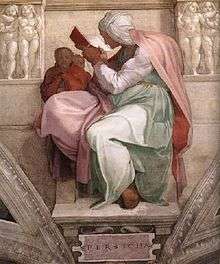Persian Sibyl

The Persian Sibyl - also known as the Babylonian, Hebrew or Egyptian Sibyl - was the prophetic priestess presiding over the Apollonian oracle.
The word "Sibyl" comes (via Latin) from the ancient Greek word sibulla, meaning "prophetess". There were many Sibyls in the ancient world, but the Persian Sibyl allegedly foretold the exploits of Alexander of Macedon. Nicanor, who wrote a life of Alexander, mentions her.[1]
The Persian Sibyl has had at least three names: Sambethe, Helrea[2] and Sabbe.[3]
Sambethe was said to be of the family of Noah.[4] A painting of Sibilla Persica by Guercino hangs in the Capitoline Museum in Rome.
Pausanias, pausing at Delphi to enumerate four sibyls, mentions a "Hebrew sibyl":
there grew up among the Hebrews above Palestine, a woman who gave oracles named Sabbe, whose father was Berosus and her mother Erymanthe. Some say she was a Babylonian, while others call her an Egyptian Sibyl.[5][6][7]
The medieval Byzantine encyclopedia, the Suda, credits the Hebrew Sibyl as author of the Sibylline oracles, a collection of texts of c. the 2nd to 4th century which were collected in the 6th century.
See also
References
- ↑ "ANCIENT SACRED WORKS OF THE HEBREWS – SIBYLLINE ORACLES-appendix with early Christian commentary". Skeptically.org. Retrieved 2013-06-26.
- ↑ Divination Ancient and Modern: An Historical Archaeological and ... – John H. Manas – Google Boeken. Books.google.com. Retrieved 2013-06-26.
- ↑ Seers, Sibyls, and Sages in Hellenistic-Roman Judaism – John Joseph Collins – Google Books. Books.google.co.uk. Retrieved 2013-06-26.
- ↑ From Jewish Magic to Gnosticism – Attilio Mastrocinque – Google Books. Books.google.co.uk. Retrieved 2013-06-26.
- ↑ Pausanias, x.12
- ↑ Sibyls and sibylline prophecy in classical antiquity, Herbert William Parke. Books.google.co.uk. Retrieved 2013-06-26.
- ↑ Seers, sibyls, and sages in Hellenistic-Roman Judaism, John Joseph Collins. Books.google.co.uk. Retrieved 2013-06-26.
External links
![]() Media related to Sibyl of Persia at Wikimedia Commons
Media related to Sibyl of Persia at Wikimedia Commons
_-_Persian_Sibyl.jpg)